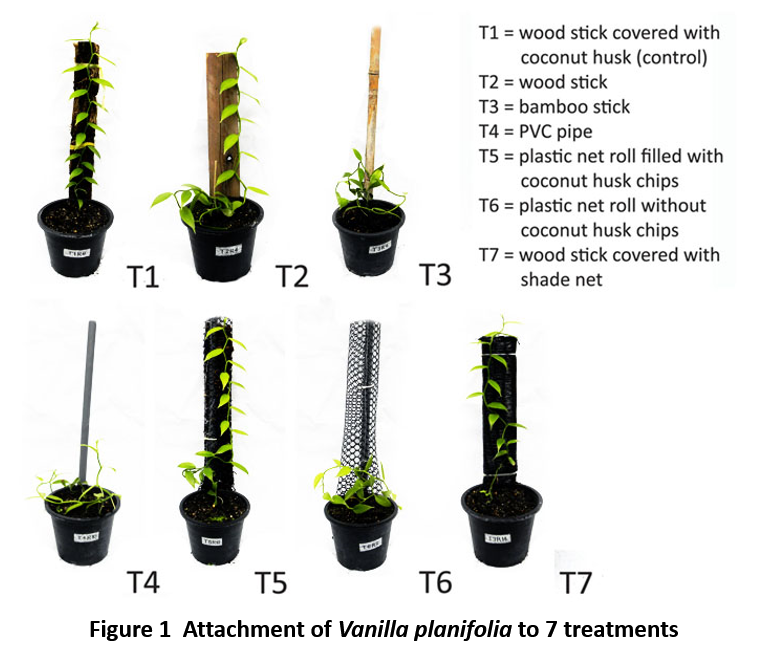Paul Kasemsap
พรพิพัฒน์ เกษมทรัพย์

~growing plants for improved wellbeing
The appropriate supporting material for micropropagated Vanilla planifolia Jacks. ex Andrews plantlet
วัสดุเกาะยึดที่เหมาะสมสำหรับการปลูกต้นอ่อนวานิลลาที่ได้จากการขยายพันธุ์ด้วยการเพาะเลี้ยงเนื้อเยื่อ
Kasemsap, P & Boonkorkaew, P. 2014. Appropriate supporting material for micropropagated Vanilla planifolia Jacks. ex Andrews plantlet. Agricultural Science Journal (Suppl.), 45(3): 333-338.
[Original full text in Thai; บทความเป็นภาษาไทย]

บทคัดย่อ
การศึกษาวัสดุเกาะยึดที่เหมาะสมเพื่อเพิ่มทางเลือกแก่ผู้ปลูกต้นอ่อนวานิลลาที่ได้จากการขยายพันธุ์ด้วยการเพาะเลี้ยงเนื้อเยื่อให้สามารถใช้วัสดุที่มีในท้องถิ่นได้สะดวก และคุ้มค่าขึ้น ใช้แผนการทดลองแบบสุ่มสมบูรณ์ ประกอบด้วยการย้ายปลูกต้นอ่อนที่ผ่านการปรับสภาพแวดล้อมลงในวัสดุปลูกพีทมอส : แกลบเผา : ทรายหยาบ (1:1:1) ร่วมกับการใช้วัสดุเกาะยึด 7 ชนิด (7 สิ่งทดลอง สิ่งทดลองละ 15 ซ้ำ) ได้แก่ 1) แท่งไม้หุ้มด้วยกาบมะพร้าว (Control) 2) แท่งไม้ 3) ไม้ไผ่ 4) ท่อพลาสติก PVC 5) ตาข่ายพลาสติกม้วนหุ้มมะพร้าวสับ 6) ตาข่ายพลาสติกม้วน และ 7) แท่งไม้พันด้วยตาข่ายพรางแสงพลาสติก บันทึกข้อมูลระยะเวลาที่ใช้ในการเกาะยึด และการเจริญเติบโตของต้นอ่อน ตั้งแต่เดือนมีนาคมถึงเดือนพฤษภาคม พ.ศ. 2555 เป็นระยะเวลา 12 สัปดาห์ พบว่า ชนิดของวัสดุเกาะยึดส่งผลต่อการเกาะยึด และจำนวนรากอากาศ แต่ไม่มีผลต่อจำนวนใบ เส้นผ่านศูนย์กลางลำต้น และความสูงลำต้นของต้นอ่อนวานิลลา โดยการใช้แท่งไม้หุ้มด้วยกาบมะพร้าว ตาข่ายพลาสติกม้วนหุ้มมะพร้าวสับ และแท่งไม้พันด้วยตาข่ายพลาสติกพรางแสง ทำให้มีจำนวนต้นอ่อนที่เกาะยึดกับวัสดุสูงสุด คือร้อยละ 100, 86.7 และ 73.3 ตามลำดับ และการใช้ตาข่ายพลาสติกม้วนหุ้มมะพร้าวสับ ทำให้ต้นอ่อนสร้างรากอากาศใหม่ได้จำนวนสูงสุด ดังนั้น จึงสามารถใช้วัสดุเกาะยึดทั้ง 7 ชนิดปลูกเลี้ยงต้นอ่อนวานิลลา เนื่องจากทุกวัสดุให้ผลการเจริญเติบโตโดยรวมไม่แตกต่างกัน อย่างไรก็ตาม การเลือกวัสดุที่ทำให้มีจำนวนต้นอ่อนเกาะยึดสูง อาจเพิ่มความสะดวกในการดูแลรักษาได้
คำสำคัญ : กล้วยไม้ วัสดุปลูก การเพาะเลี้ยงเนื้อเยื่อ
Abstract
The study of appropriate supporting materials for micropropagated Vanilla planifolia Jacks. ex Andrews plantlet
consists of following steps I. transplanting acclimated plantlets into a potting media mixture of
peat moss : rice husk charcoal : sand (1:1:1); II. applying 7 different supporting materials (7 treatments, 15 replications/ treatment)
to the plantlets using CRD including 1) a wood stick covered with coconut husks (control), 2) a wood stick, 3) a bamboo stick,
4) a PVC pipe, 5) a plastic net roll filled with coconut husk chips, 6) a plastic net roll and 7) a wood stick covered with
a shade net; and III. observing the attachment to the supporting materials as well as plantlets’ vegetative growth from
March to May 2012 in total of 12 weeks. The results showed that supporting materials affected plantlets’ attachment and
a number of new aerial roots generated while there was no effect on a number of leaves, stem diameters and stem lengths.
The highest attachment percentages at 100%, 86.7% and 73.3% were found in the wood stick covered with coconut husks,
the plastic net roll filled with coconut husk chips, and the wood stick covered with the shade net, respectively.
Moreover, the plastic net roll filled with coconut husk chips results in the highest number of aerial roots.
As the seven supporting materials used in this experiment shown to have no significant effect on overall plantlet
vegetative growth, therefore, all of them can be used in a commercial vanilla production depending on individual
growers’ preference and availability. However, using the supporting materials which gave a higher attachment rate may result in lower maintenance.
Keywords: orchid, medium, micropropagation
news tag:
science plant ภาษาไทย publication Read more thoughts:
-
Genome-wide Association Study of Rice Vegetative Growth under Ammonium or Nitrate Nutrition (31 Jul 2025)
-
The inaugural Bay Area Plant Hub Symposium 2025 (17 Apr 2025)
-
How can we cultivate an innovative plant science community? (16 Apr 2025)
-
[Dataset] Vegetative biomass production under different inorganic nitrogen forms of the USDA rice (Oryza sativa L.) diversity panel 1 (17 Mar 2025)
-
Mission N-Possible: Influence of Inorganic Nitrogen Forms on Small Grain Crop Carbon Assimilation (13 Sep 2024)
-
Genome-wide Association Study of Rice Vegetative Biomass under Different Inorganic Nitrogen Forms: Ammonium or Nitrate (13 Aug 2024)
-
Genetic adaptation to ammonium sustains wheat grain quality and alleviates acclimation to CO2 enrichment (23 Nov 2023)
-
Sharing research data (25 Jan 2023)
-
Breeding for Higher Yields of Wheat and Rice through Modifying Nitrogen Metabolism (23 Dec 2022)
-
Giving credit where it's due (18 Nov 2022)
-
Lessons beyond classroom: 12 opportunities to grow a better self while in college (10 Aug 2022)
-
Everything, Everywhere, All at Once (01 Aug 2022)
-
UC Davis Plant Sciences Symposium 2022 Award Winners Announced - Paul gave the best student talk! (27 Jun 2022)
-
I was told that: It's what you do that defines you. Is it? (20 May 2022)
-
I was told that: Opportunity is like a bus (20 May 2022)
-
Can we use personalized ads to improve our decision? (12 May 2022)
-
If you could choose better, would you? (12 May 2022)
-
How pottery helps me write (10 May 2022)
-
We need more conflicts (08 May 2022)
-
Rate My Lab! - A yelp-like platform to grade your advisor? (01 May 2022)
-
Life outside the lab - exploring passion projects beyond research (27 Apr 2022)
-
Thought of the week: Trash hunt squad? (22 Apr 2022)
-
Never have I ever… coded (and wondered into the world of data science) (18 Feb 2022)
-
Where do we get protein in our daily diets? (01 Jun 2021)
-
ภาษาไทย (15 May 2021)
-
Hello World (13 May 2021)
-
Find a talk - What if we can find all the talks in the world? (09 May 2021)
-
Meet Public Scholarship and Engagement Prize Winner: Paul Kasemsap (19 Apr 2021)
-
Meet the Fulbrighters Series: Pure & Applied Science - Paul joined a panel sharing Fulbright experience in the USA (30 Mar 2021)
-
Meet Paul Kasemsap, Horticulture & Agronomy Graduate Student and Grad Slam Finalist (19 Mar 2021)
-
ชีวิตติดโชค (01 Nov 2020)
-
ไนโตรเจน...ธาตุอาหารพืชเปลี่ยนโลก (05 Aug 2020)
-
Grad Innovator Fellowship 2020: Meeting Global Protein Demands and Optimizing Resources in the Face of Climate Change (01 Apr 2020)
-
Rising atmospheric CO2 concentration inhibits nitrate assimilation in shoots but enhances it in roots of C3 plants (23 Oct 2019)
-
UC Davis Plant Breeding Center Graduate Student Spotlight (01 Jun 2018)
-
“ไบเออร์” สร้างยุวชนเกษตร รับมือปัญหาความมั่นคงทางอาหาร (15 Nov 2017)
-
2 ยุวชน..หัวใจเกษตร กับเวทีสำคัญ..ภารกิจช่วยโลก!! (12 Nov 2017)
-
การประชุมสุดยอดยุวชนเกษตร (Youth Ag-Summit) ปี พ.ศ. 2560 (27 Oct 2017)
-
Characterisation of Arabidopsis thaliana candidate genes putatively involved in the response to salt stress (08 Jul 2015)
-
First day of class in Wageningen (21 Jun 2015)
-
A year in Wageningen UR (19 Jun 2015)
-
Fietsen are sustainable! (18 Jun 2015)
-
Changes in photosynthetic and other yield components contributing to yield improvement of Dutch tomato (01 Jun 2015)
-
การเดินทางจากสนามบิน Schiphol สู่ Wageningen (12 Aug 2013)
-
The appropriate supporting material for micropropagated Vanilla planifolia Jacks. ex Andrews plantlet (08 May 2013)
-
Effect of Drought Stress on Chlorophyll Fluorescence and Net CO2 Exchange Rate of Vanilla planifolia Jacks. ex Andrews (25 Mar 2013)